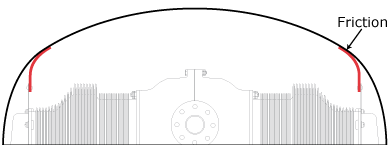Part Number: CS085X36X36G



Product Details
Recommended for larger aircraft. Allows fabrications of straight, curved or irregular shaped baffle seals that cannot be cut from 3 inch strips.
| Thickness | Size | Color |
| .085 inches | 36 in x 36 in | Black/Gray |
Cowl Saver™ Baffle Seal Material with Bi-Flex™ Technology
Reduce airframe vibration, stop cowl and firewall cracks
You can feel the difference in the cockpit!

Baffle Seal Friction Causes Airframe Vibration and Destroys Cowls
Typical silicone rubber baffle seals have a coefficient of friction among the highest of any known material. This friction transfers engine vibration into your cowl and firewall causing fastener fretting, fatigue, cracking, chaffing and airframe vibration.
Cowl Saver™ Baffle Seal Material has 30 Times Less Friction!
- One side is silicone and the other is a low friction Teflon coated rubber unique to the patented Cowl Saver™ baffle seal material
- Cowl Saver™ dramatically reduces the friction between your cowl and baffle seals
- Half of the engine vibration you feel in the cockpit is from baffle seal transfer
Low friction Saves You Money!
- Reduces transfer of vibration to the engine cowl and airframe
- Eliminates cowl erosion
- Extends baffle seal life
- Reduces expensive cowl and cowl fastener repairs
- Reduces fatigue and cracking in baffles, cowl skins and firewall
- Cowling even goes on easier!
Unbeatable performance
- Ideal balance of flexibility and stiffness
- Fiberglass reinforced
- Meets industry standard AMS3320G
- Use scoring tool P/N TOOL120 for Customized flexibility for optimal cooling
Bi-Flex™ Technology
Bi-Flex™ Technology utilizes a laser engraved waffle pattern to provide the ideal flexible seal for maximum cooling, while retaining rigidity on the lower half of the seal to prevent the baffle seal from blowing past the proper seal position against the cowl.
|
P/N |
Size |
|
|
18 in X 36 in |
||
|
36 in X 36 in |
||
|
3 in X 36 in with Bi-Flex™ |
||
|
3 in X 108 in with Bi-Flex™ |
||
|
3 in X 156 in with Bi-Flex™ |
||
|
Color: Black/Gray |
||
|
Note: For proper function, install Cowl Saver™ material so that only the low friction (black) side touches the cowl's inside surface. Carefully plan the baffle seal installation before cutting the material. |
Baffle seals created using this product are protected by U.S. Patent No. US 8,070,099 B2
Supersedures
Eligibility Notice
Click here to view product eligibility.
| OEM Part Number | McFarlane Part Number | Comment |
| CS085X36X36G-B | CS085X36X36G |
Related Categories
Eligible Aircraft
| Make | Series | Model | Beginning S/N | Ending S/N | Eligibility Chart |
| Many | Many | Many | 0 | ZZZZZZZZZZZZZZZ |
Related Documents
Press Releases
| 2007-04-25 Cowl Saver Baffle Seals |
| 2010-12-16 Cowl Saver Baffle Seals for Cessna 172R and 172S |
| 2015-12-07 Cowl Saver with Bi-Flex |
| 2018-08-10 Cessna 208, 208B Caravan Products |
Maintenance and Product Guides
| Cowl Saver Engine Baffle Seal Allows Customized Flexibility for Optimal Cooling |
Related Product Catalog Pages
| Airforms Catalog Information |
| Cowl Saver Product Flyer |
Frequently Asked Questions
Related Videos
Related Items
Please verify product details for suitability for your application.
 WARNING: Cancer and/or Reproductive Harm - www.P65warnings.ca.gov
WARNING: Cancer and/or Reproductive Harm - www.P65warnings.ca.gov




